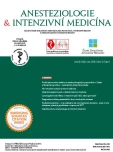Effects of infusion solution on blood coagulation
Authors:
S. Ševčíková; M. Durila; T. Vymazal
Authors‘ workplace:
Klinika anesteziologie, resuscitace a intenzivní medicíny, 2. lékařská fakulta Univerzity Karlovy, Fakultní nemocnice v Motole
Published in:
Anest. intenziv. Med., 29, 2018, č. 5, s. 258-264
Category:
Overview
Crystalloids and colloids are ubiquitous in perioperative and intensive care medicine. However, there is still a vivid debate about which solution has the minimal negative effect on coagulation. The following article summarizes the existing knowledge about the influence of infusion solutions on blood coagulation measured by standard coagulation tests such as PT and APTT, and also using tromboelasthography and rotational thromboelastometry. The goal was to determine which infusion solution has the least negative effect on blood coagulation in the published literature.
KEYWORDS
isotonic solution – blood coagulation – thromboelastometry
Sources
1. Myburgh JA, Mythen MG. Resuscitation Fluids. N Engl J Med. 2013;369:1243–1251.
2. Mauch J, Madjdpour C, Kutter AP, et al. Effect of rapid fluid resuscitation using crystalloids or colloids on hemostasis in piglets. Paediatr Anaesth. 2013;23:258–64.
3. Rasmussen KC, Secher NH, Pedersen T. Effect of perioperative crystalloid or colloid fluid therapy on hemorrhage, coagulation competence, and outcome: A systematic review and stratified meta-analysis. Casey. K, ed. Medicine. 2016;95:e4498.
4. Mohd Yunos N, Bellomo R, Hegarty C. Association between a chloride-liberal vs. chloride-restrictive intravenous fluid administration strategy and kidney injury in critically ill adults. JAMA. 2012;308:1566–1572.
5. Kuca T, Butler MB, Erdogan M, Green RS. A comparison of balanced and unbalanced crystalloid solutions in surgery patient outcomes. Anaesth Crit Care Pain Med. 2016.
6. Allen SJ. Fluid Therapy and Outcome: Balance Is Best. The Journal of Extra-corporeal Technology. 2014;46:28–32.
7. Self WH, Semler MW, Wanderer JP, et al. Saline versus balanced crystalloids for intravenous fluid therapy in the emergency department: study protocol for a cluster-randomized, multiple-crossover trial. Trials. 2017;18:178.
8. Rasmussen KC. Effect of perioperative crystalloid or colloid fluid therapy on hemorrhage, coagulation competence, and outcome. Danish Medical Journal. 2016;63.
9. Van der Linden P, Ickx BE. The effects of colloid solutions on hemostasis. Canadian Journal of Anaesthesia. 2006;53(6 Suppl):S30–9.
10. Hung MH, Zou C, Lin FS, et al. New 6 % hydroxyethyl starch 130/0,4 does not increase blood loss during major abdominal surgery. A randomized, controlled trial. Journal of the Formosan Medical Association. 2014;113:429–435.
11. Lobo DN, Stanga Z, Aloysius MM, et al. Effect of volume loading with 1 liter intravenous infusions of 0.9% saline, 4% succinylated gelatine (Gelofusine) and 6% hydroxyethyl starch (Voluven) on blood volume and endocrine responses: a randomized, three-way crossover study in healthy volunteers. Crit Care Med. 2010;38:464–70.
12. Thomas-Rueddel DO, Vlasakov V, Reinhart K, et al. Safety of gelatin for volume resuscitation--a systematic review and meta-analysis. Intensive Care Med. 2012;38:1134–1142.
13. Hartog CS, Kohl M, Reinhart K. A Systematic Review of Third-Generation Hydroxyethyl Starch (HES 130/0.4) in Resuscitation. Anesthesia & Analgesia. 2011;112:635–645.
14. Doherty M, Buggy DJ. Intraoperative fluids: how much is too much? British Journal of Anaesthesia. 2012;109:69–79.
15. Halset JH, Hanssen WS, Espinosa A, Klepstad P. Tromboelastography: variability and relation to conventional coagulation test in non-bleeding intensive care unit patients. BMC Anesthesiology. 2015;15:28.
16. Veigas PV, Callum J, Rizoli S, et al. A systematic review on the rotational thrombelastometry (ROTEM®) values for the diagnosis of coagulopathy, prediction and guidance ofblood transfusion and prediction of mortality in trauma patients. Scandinavian Journal of Trauma, Resuscitation and Emergency Medicine. 2016;24:114.
17. Durila M. Tromboelastografie a tromboelastometrie. In: Ševčík P. Intenzivní medicína. 3. dopl. vyd. Galén. 2014:197–200.
18. Benes J, Zatloukal J, Kletecka J. Viscoelastic Methods of Blood Clotting Assessment – A Multidisciplinary Review. Frontiers in Medicine. 2015;2:62.
19. Adler M, Ivic S, Bodmer NS, et al. Thromboelastometry and Thrombelastography Analysis under Normal Physiological Conditions – Systematic Review. Transfusion Medicine and Hemotherapy. 2017;44:78–83.
20. Kozek-Langenecker SA, Ahmed AB, Afshari A, et al. Management of severe perioperative bleeding: guidelines from the European Society of Anaesthesiology: First update 2016. Eur J Anaesthesiol. 2017;34:332–395.
21. Rossaint R, Bouillon B, Cerny V, et al. The European guideline on management of major bleeding and coagulopathy following trauma: fourth edition. Critical Care. 2016;20:100.
22. Schlimp CJ, Cadamuro J, Solomon C, et al. The effect of fibrinogen concentrate and factor XIII on thromboelastometry in 33% diluted blood with albumin, gelatine, hydroxyethyl starch or saline in vitro. Blood Transfusion. 2013;11:510–517.
23. Weiss G, Lison S, Spannagl M, Heindl B. Expressiveness of global coagulation parameters in dilutional coagulopathy. British Journal of Anaesthesia. 2010;105:429–436.
24. Sawhney C, Subramanian A, Kaur M, et al. Assessment of hemostatic changes after crystalloid and colloid fluid preloading in trauma patients using standard coagulation parameters and thromboelastography. Saudi J Anaesth. 2013;7:48–56.
25. Ponschab M, Schöchl H, Keibl C, et al. Preferential effects of low volume versus high volume replacement with crystalloid fluid in a hemorrhagic shock model in pigs. BMC Anesthesiology. 2015;15:133
26. Sevcikova S, Vymazal T, Durila M. Effect of Balanced Crystalloid, Gelatin and Hydroxyethyl Starch on Coagulation Detected by Rotational Thromboelastometry In Vitro. Clinical Laboratory. 2017;63(10/2017).
27. Shin, HJ, Na HS, Do SH. The effects of acute normovolaemic haemodilution on peri-operative coagulation in total hip arthroplasty. Anaesthesia. 2015;70:304–309.
28. Golparvar M, Saghaei M, Hamidi H, et al. Comparative evaluation of the effects of hydroxyethyl starch on coagulation state of patients during brain tumor surgeries in comparison to crystalloids by thromboelastography. Journal of Research in Medical Sciences: The Official Journal of Isfahan University of Medical Sciences. 2014;19:8–12.
29. Marx G, Schuerholz T. Fluid-induced coagulopathy: does the type of fluid make a difference? Critical Care. 2010;14:118.
Labels
Anaesthesiology, Resuscitation and Inten Intensive Care MedicineArticle was published in
Anaesthesiology and Intensive Care Medicine

2018 Issue 5
Most read in this issue
- Using propofol − what is forbidden, is not (really) allowed ... or what are we risking if we use it in contradiction with the SPC?
- Regional anaesthesia for knee joint surgery – peripheral nerve blocks with minimal impact on motor function of the lower limb
- Effects of infusion solution on blood coagulation
- Cytomegalovirus infection in intensive care. Treat or ignore them?
